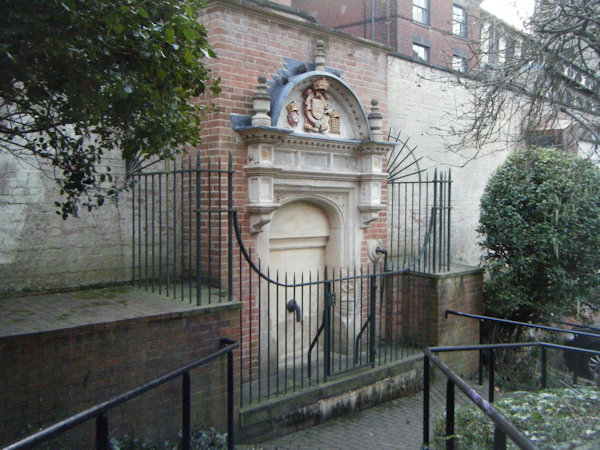 |
Dedication: Saint Laurence Location: Norwich Coordinates: 52.6311N, 1.29071W Grid reference: TG227087 Heritage designation: Scheduled monument |
 |
Dedication: Saint Laurence Location: Norwich Coordinates: 52.6311N, 1.29071W Grid reference: TG227087 Heritage designation: Scheduled monument |
St Laurence's Well, or, as it later became known, Gybson's Conduit, seems to have had an association with the nearby St Laurence's Church, and probably does not predate it, as St Laurence's cult, though popular, was not at all local. This church was constructed between the years of 1460 and 1472, so it is likely that the well's connection with St Laurence dates from either that time or slightly later. (Although Francis Blomefield states in An Essay Towards a Topographical History of the County of Norfolk that it was extant in the time of Edward I, he notes that back then it was a "common well", which does not necessarily mean that it was originally dedicated to St Laurence.)
Regardless of its dedication, the well was evidently of use to the people of Norwich during the medieval era. When Robert Gibson, a beer brewer and the Sheriff of Norwich, wished to gain control of St Lawrence's Lane (which had been granted to the parishoners in 1547, to allow them access to the water source), he was permitted to do so, on the condition that the "common people" were still able to access the water in some way. This event was recorded in the Norwich Assembly Books, parts of which were published by Mr M. Knights in 1888 in volume 10 of Norfolk Archaeology under the date of the 26th of April, 1577:
|
This day it is also agreed by the consent of this assembly that Robert Gybson shall have the little entry that goeth out of the street to St. Laurence well, the which well and entry lieth between the tenement and the garden of the said Robert, with this proviso, that the same Robert shall at his proper costs and charges in a conduit or cock of lead bring the water from the said well up into the street for the ease of the common people, and for the maintenance of the same conduit and cock wherein the water shall be conveyed: the said Robert here promised that he will bind the messuage wherein he dwelleth to the Mayor, shreeves, citizens, and commonalty, by such reasonable devices as by the counsel of the city shall be devised. |
The well got another mention in the Norwich Assembly Books in 1594, which recorded an "indenture sealed to Robert Gibson of a certain entry of passage to the Fountain in the parish of St. Laurence, commonly called St. Laurence Well, for 300 years".
Although Gibson only constructed the new pump, which soon became known as "Gybson's Conduit", because he was forced to, the inscription that he had painted on the face of the structure was designed to sing his praises. It has been transcribed several times over the centuries, although each version differs slightly from the next; John Chambers, writing in volume 2 of A General History of the County of Norfolk, published in 1829, noted that the inscription had been "altered in its orthography when the pump was beautified", which may explain the variation between each version. Francis Blomefield included the earliest of these transcriptions in An Essay Towards a Topographical History of the County of Norfolk, which was first published in around 1809 but which was written in the mid 18th century, and which presumably predates the pump's "beautification":
|
This Water here cavght, Gybson hath it sowghte, Thy Ease was his Coste, not smal, |
The conduit once faced the road, but was, relatively recently, altered to face in the opposite direction, and all supply of water to the pump appears to have been cut off. When I visited in the February of 2025, the site was in considerably good condition, although the inscription was in some parts unreadable.
|
Access: The well is located at the end of a short public road. |
Copyright 2025 britishholywells.co.uk